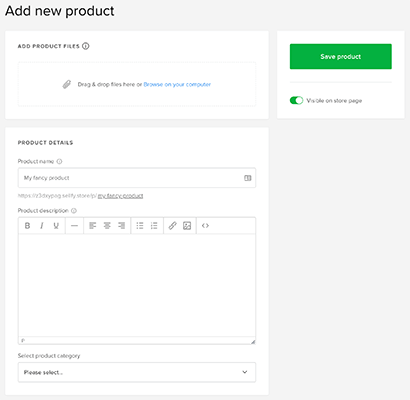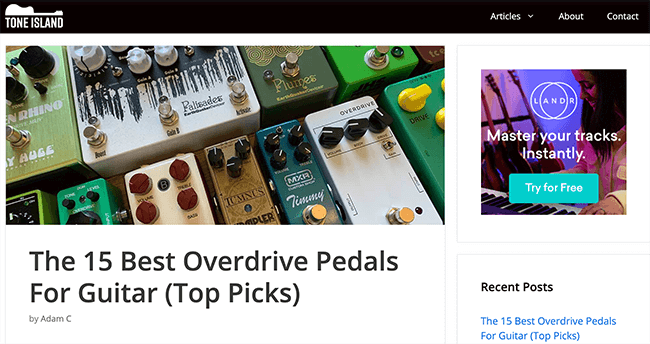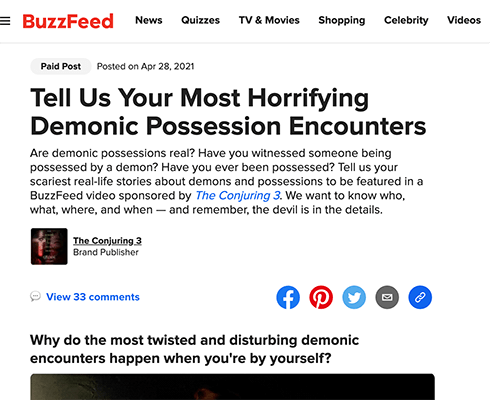The Best Ways To Monetize Your Blog (And Why Most Bloggers Fail)

Are you looking for the best ways to monetize your blog?
Maybe you’re earning some money from your blog already and want to increase your revenue.
Or maybe you are about to start your blog and want to get a plan ready for when you launch.
Either way – I’ve got you covered.
In this post, I’m going to share everything you need to know about the most popular ways to monetize a blog.
But first, we need to talk about the biggest reason most bloggers don’t make any money – and how you can avoid it.
Ready? Let’s get started:
Warning: Earning money from a blog is NOT a quick process. It takes time, patience, and a lot of hard work. If you’re looking for a quick way to make cash, you won’t find it here. But if you’re willing to put in the work, continue reading.
The biggest reason most bloggers don’t make any money
There’s a lot of advice on how to earn money as a blogger.
The problem? Most of it misses out on the fundamentals.
And it is these fundamentals that provide you with the building blocks you need to make your blog successful.
Here’s the deal:
There are 4 components of any content based business. This applies to podcasts, blogs, YouTube channels, and all that good stuff.
If these components aren’t in sync, it is the equivalent of trying to row up a waterfall with broken paddles.
What are these components?
Business Model ⮂ Audience ⮂ Content ⮂ Marketing.

I have nicknamed this the BACM framework. Not the most interesting name but it works.
The idea is that everything needs to flow. You start off figuring out your business goals and business model. Essentially, how will you make money? How will you monetize?
Then, you figure out your target audience, your content strategy, and how you will market that content.
The problem is that when some bloggers start out, they will choose a business model that doesn’t fit with their audience, content, or marketing.
A good example is a blogger that uses an ad network like Google AdSense to make money, but publishes reviews that are unlikely to gain much traffic.
In this example, you would be much better off using affiliate marketing to monetize reviews, and use SEO as your primary marketing channel.
Each part of your business must support each other. Everything needs to fit like a glove. Choose the best content strategy and marketing channels for your business model & target audience.
But also remember that certain blog monetization methods will be quicker than others. For example, you’ll get paid quicker with freelancing whereas affiliate marketing is slower but can often lead to passive income.
Note: Display ads make most sense when they don’t interrupt more profitable conversion goals, and your site can scale traffic efficiently. For example, its not worth losing a potential freelancing gig that could be worth $40K over the lifetime of the account, if you only get a few cents for sending them away from your site.
The best ways to monetize your blog
Now, let’s take a look at the best ways to monetize your blog:
1. Freelancing
If you’re looking for a quicker way to earn money from your blogging skills, freelancing is the best option.
In general, earning money from a blog is a slow process but freelancing is usually much quicker if you can find paying clients.
While most bloggers tend to go down the freelance writing route, there are plenty of other services you can offer.
Think about it like this:
Whatever you do for your own blog, there’s a chance that someone else will pay you to do that for them.
For example:
- Content writing
- Copywriting
- Proofreading + copy editing
- Social media management
- Email marketing
- Video editing
- Graphic design
- Web design
- SEO
- Content promotion
And the great thing is that the work you do for your blog acts as a portfolio.
Freelancing can also open you up to new opportunities and on occasions, help you grow your own blog.
In fact, I’ve been getting job offers for years thanks to my blog despite the fact that I don’t offer any services.
I’ve even had to decline some pretty incredible opportunities from folks like Noah Kagan.
Here’s the bottom line: the skills we learn as bloggers are in high demand right now. And that demand is only going to increase.
Note: Not sure where to find freelancing jobs? Check out our roundup of freelance job websites to get started.
2. Sell online courses
The e-learning space is blowing up right now. More and more people are wanting to level-up their skills or learn something new.
In order to get the best from this tactic and serve your audience, you need to have mastered the topic you want to create your course on.
And there’s a lot of upfront work in terms of planning, content creation, etc. And you need a solid marketing plan that you can implement once you launch your course.
If you build a team of affiliates you can start generating sales fairly quickly.
Now, the great thing about online courses is that they can generate revenue for years to come and they reduce your reliance on unpredictable traffic sources like Google.

Online course platforms make it easy to create and sell courses. And in the case of Thinkific, you can launch your first course for free.
Note: You’ll need a course platform with a learning management system to offer the best experience for your students. Check out our post on online course platforms for some recommendations.
3. Sell digital products
Digital products are another option and they can sometimes be easier than selling courses. Particularly in the case of bundles of templates.
Some folks have built template businesses off the back of free graphic design tools like Canva.
And there are various types of digital products you could sell:
- Ebooks
- Podcasts
- Webinars
- Templates
- Checklists
- Bundles of products
- Subscriptions
Whichever products you decide to sell, just be sure to choose those that align with your business goals, and needs of your audience.
Now, you will need some sort of ecommerce platform so you can accept payments and deliver the products to your customers.
Depending on what you’re selling, you could go down the route of using a marketplace. You will have to share your profits but can sometimes leverage a built-in audience & established trust of the platform.
Amazon Kindle is a good option for ebooks.
And Etsy is a good option for anything creative. In fact, plenty of bloggers are using Etsy to sell digital products like planners, ebook templates, lead magnet templates, and all sorts of things.
Outside of marketplaces, you could go for a platform like Sellfy which would allow you to sell ebooks and other digital products. Both digital and physical products.

Podia is good option, particularly if you’d like to sell courses. It comes with a learning management system for courses. You can sell subscriptions, webinars, and other things.
It also handles customer messaging, affiliate tracking, and more.
4. Advertising
Advertising is probably the most popular way to monetize a blog. You can sign up for an advertising network and some code to your site – that’s it.
However, when it comes to actually earning money, it is definitely a slow burn unless you have an existing site with traffic.
Most bloggers struggle to make money from ads because their content strategy doesn’t align with this specific business model. Remember the BACM framework from earlier? That’s even more important with this monetization method.
Your content strategy will hinge on your ability to scale your content output and publish content that naturally attracts traffic in droves.
This means shorter articles and being smart about the content types you incorporate into your overall strategy.
Newsworthy content and viral content will be your bread and butter. And encouraging social sharing will be a top priority (these social share plugins will help).
However, it is also important to publish keyword focused content every once in a while. Driving traffic from SEO will help your site’s overall visibility.
SEO traffic won’t be as profitable as social media visitors when it comes to ads, but there are additional benefits to doing this.
For example, you could diversify your blog monetization strategy by adding affiliate marketing into the mix.
Note: Ready to monetize your blog with advertising? You’ll need to choose an ad network. Check out our article on the best ad networks to find the right one for you.
5. Affiliate marketing
What is affiliate marketing exactly?
It is a popular way to monetize a blog, where you are paid on a cost-per-action (CPA) basis.
Essentially, you promote someone else’s product and they pay you a commission for sales.
It is a nice way to monetize a blog because you can get started right away and you don’t have to worry about handling customer support like you would selling courses or digital products.
So, how do you get started with affiliate marketing?
You need to consider your approach before you get started. There are generally two ways to go about this.
Option 1 – The social influencer
This option relies upon you building a highly engaged audience. Social media would be a key traffic driver for you but email marketing could work equally well instead, or in addition to it. And you would focus on a handful of industry leading products.
This approach works especially well with YouTube.
For example, Philip McKnight of Know Your Gear includes affiliate links to the guitar gear he demos in his videos:

If you don’t do anything with video, email marketing would be your best traffic driver. However, you’ll get the most mileage if you combine content types – written content, video, and podcasts.
Option 2 – The authority site
Authority sites typically rely mostly on driving traffic from search engines like Google. Traffic can be more passive with this approach but it is also more unpredictable.
Initially you would focus on a handful of products and expand outwards creating more reviews and product-centric list posts as you go. Transitioning from a small blog to an authority site.
For example, this is the approach I’m taking with my guitar blog, Tone Island.

So, I’m working through articles on all of the guitar products that I have a personal interest in.
Once you know which approach you will be taking, it is time to find products/services to promote.
I recommend starting with ones that you are most familiar with. Start with a quick online search to see if they offer an affiliate program. Search for something like “affiliate program”+”product/brand name”.
Be sure to keep them relevant and only promote top-tier products. And disclose your affiliate links.
Note: Some affiliate programs will be handled directly through a brand, or ecommerce store. For other programs, they will be managed by a dedicated affiliate network. These are great because they give you access to a lot of affiliate programs in a single platform. Check out our article on affiliate platforms to learn more.
6. Sponsored content
Sponsored content can be a highly effective way to monetize your blog but you’ll need your blog to be well established before you can attract sponsors.
In fact, the main challenge is finding sponsors.
However, on a positive note, you get to choose who you want to work with and set your own prices.
A good starting point is to create an advertising page that lists your rates for ads and sponsored content.
You should also create a media kit that you can send out to potential sponsors. This would include details on your blog’s traffic, social media following, email list, demographics, target audience, etc.
The sponsored content you create would depend largely on what potential sponsors are looking for.
This could be anything from a product review to something more viral in nature like this Buzzfeed article:

It is worth mentioning that some brands will expect you to say good things about them because you’re being paid.
Let’s go with a product review as an example. You’d need to be up front about the fact that you are selling a review – warts and all. You’re not selling “positive reviews” – because editorial integrity is important.
However, some sponsors may be concerned that they could end up paying you to trash their brand.
The best way to alleviate these concerns is to test the product first and decline to review it if it is really bad. Share your feedback so they can improve things. If they do, you’ll be able to move ahead with the review.
Note: You should always disclose sponsored content and be transparent with your readers. And, any sponsored links should be tagged as “sponsored” or “nofollow”.
7. Coaching or consulting
Think of coaching and consulting as freelancing 2.0.
You can typically command much higher prices and would generally serve more as an advisor or mentor. So, you wouldn’t be the one handling implementation of anything generally, unlike with freelancing.
However, you do have to be able to demonstrate greater expertise. This is why I always recommend freelancing first. Once you are more established and have a significant amount of expertise, coaching & consulting is a great next step.
One route that some folks take is to start with freelancing, then transition to an agency to give them the ability to scale. Then, once they’ve hired staff to fulfil their client-facing role, they are able to free up their time for higher paying clients as a consultant.
You’re able to charge more for this type of work purely because the more experience you have, the more valuable your insights are to other businesses.
As soon as you’re ready, create a conversion-focused landing page on your blog so you can let the world know that you’re available for coaching/consulting.
Note: You could also create a sales funnel to promote your lower priced products on the front-end, then promote your high ticket offers (e.g. coaching) on the back-end using email automation.
Wrapping it up
How should you monetize your blog? This answer depends on you, your business model, and your audience.
I’ve covered the most popular options above to give you a solid starting point.
Regardless, you should focus on one blog monetization method and develop that revenue stream first. Then move onto the next.
Related Reading:
- 13 Ways To Make Money From A Website (And How To Get Started)
- How Do Influencers Make Money? The Complete Guide
- 20+ Passive Income Ideas To Build Your Wealth
Disclosure: Our content is reader-supported. If you click on certain links we may make a commission.
